What I Saw – by Jackie Philpott

In this month’s column I write about two different types of sailing lunacy: Iceboat racing on hard water in Wisconsin and the Three Bridge Fiasco on soft water in the San Francisco Bay. Ladies and gentlemen, pick your poison.
Just in case you don’t want to read about iceboating, here is the website for Four Lakes Ice Yacht Club where you can watch iceboat racing videos instead: https://www.iceboat.org/regattas/internationalskeeterassociation/
This site is meticulously maintained by Deb Whitehorse of the Four Lakes Ice Yacht Club. If iceboat racing videos don’t grab you, I just don’t know what I can do to catch your attention.
Everything You Always Wanted To Know About Iceboats
Back in December of 2022 I travelled to Madison, Wisconsin for business. While I was there I invited myself to Daniel Hearn’s workshop in Sun Prairie, Wisconsin. My colleague, Amy Johanning and I drove out to meet him. He showed us around and explained the differences between sailboats and iceboats. And boy are there a lot of differences!
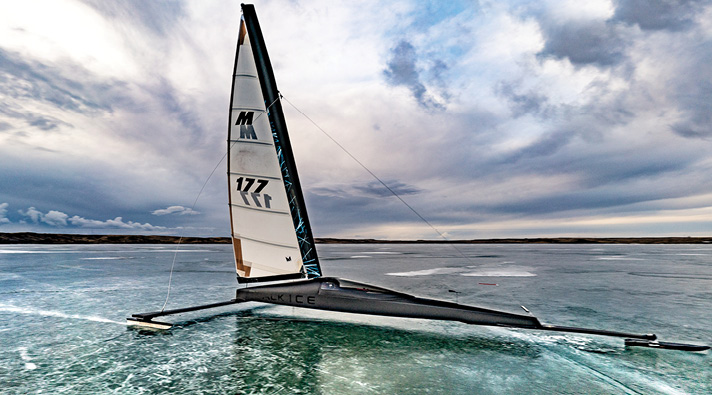
Daniel owns a marketing firm which partly explains the fabulous photographs and the high quality of the images. It is not coincidental that a photo of his own boat was chosen to sell the Black Ice line of a Swedish sportswear company called Sail Racing. However, it doesn’t explain everything else, such as the intensity that is shared by certain types of sailors whether they are in California, Lithuania, Poland, Hungary or the Midwest. Daniel builds boats in his workshop which is called the State Street Syndicate. He is also currently the commodore of the Four Lakes Ice Yacht Club. Here is what he told us about iceboating:
Daniel: We’ll generally start racing here about the third week of December. We haven’t had a lot of cold weather yet. Before I acquired this workshop here I built everything in the basement of my house on State Street in Madison. I had to take my first boat out through a window under the back porch.
[Daniel leads us to what looks like a prototype for a rocket ship.]
This boat will be a skeeter class iceboat. Its cockpit is similar to an airplane cockpit. There is a track that slides forward and back. At the start of a race you push the iceboat to get started, you jump in the cockpit, close the canopy. It’s got a winch just like a bigger soft water sailboat. The winch controls the seating system that’s inside the hull in the back. There’s one sheet that comes out here. The sail is actually in back of it.
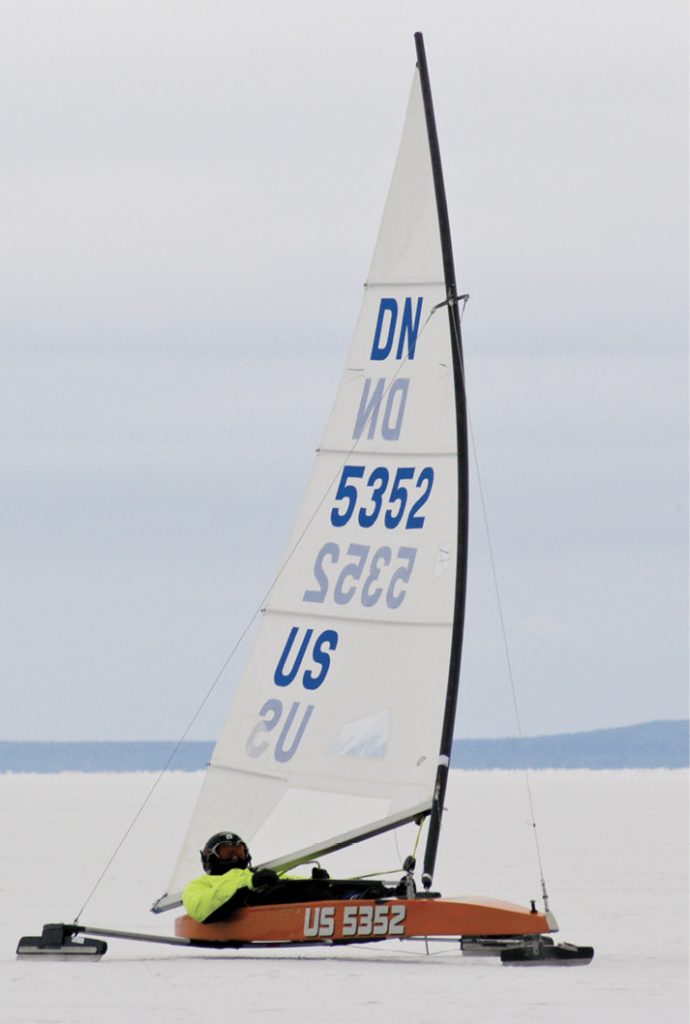
The sides are Sitka Spruce, the top is just thin skins of carbon fiber over bulkheads. You can’t see ‘em, but they are support structures underneath. Then the whole thing, on this particular boat, gets covered with carbon fiber. For the skeeter class the only limitation is the height of the mast and the square footage of the sail, which is 70 sq. ft.
Masts for these boats are light enough to raise without a crane. The foam creates the shape of the mast. All of the strength of the mast comes from the composites that are laid up over it, to get the type of bending characteristics that you are looking for. Carbon fiber has different characteristics. There is one type of carbon fiber that only runs in one direction, another that runs at diagonals and still another type that runs at 90 degrees. You use each type of carbon fiber to make the mast strong and bend the way you want it to in order to achieve maximum performance. When you get hit with a puff of wind you want it to bend – think of a rubber band – you want the mast to stretch and then snap back rather than make it just stiff: you want it to flex and translate that flex into forward motion.
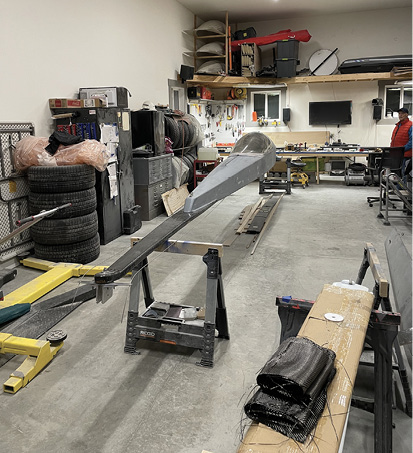
There is no weight requirement. A sailor’s weight is more often taken into consideration in soft water sailboat racing, less so in ice sailing. Some boats that are fairly light will often carry extra weight in the boat just to keep it more under control, be able to translate more power and speed. This has tremendous power. With an ice boat you can’t use all the power without more weight, so you add weight to translate it into speed. You’re not doing it to equalize the weight on the boat.
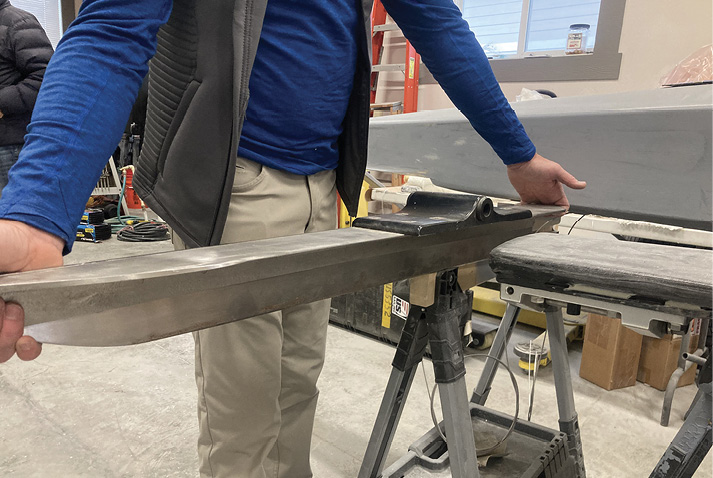
Iceboat sailors are willing to travel to where there is good ice. For instance, I just returned from three days racing in Minnesota. We had about 60 boats, boats from Nova Scotia, Ontario, Sweden, Germany, Rhode Island. This was just the first regatta of the season. It was unsanctioned, unscored, super casual.
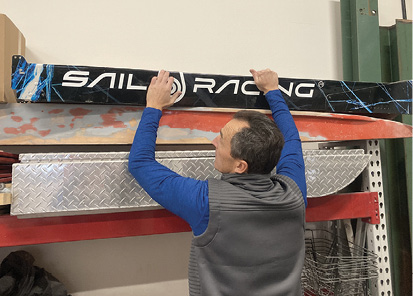
Iceboats have runners. Or skates. The plank is underneath the body, and the element in the front is called the springboard. It provides suspension. There is no downhaul. The mainsheet runs through a block on the boom and down through a block here, so when you sheet the mainsheet it not only tightens the leech of the sail but it also functions like a Cunningham or an outhaul. None of these iceboats have headsails. There are no winches, you just sheet in the mainsheet manually. There is a cleat but that can be a dangerous thing. It’s used at the start but most people don’t use it much after that because if you get hit by a puff you want to ease sheet. There are different styles of runners or skates, which are determined by the class. In one class there are steel runners but they cannot be stainless and they cannot be hardened.
Most sails on racing iceboats have carbon fiber membranes rather than Dacron. A different type of boat, called a stern steerer, has a tiller. They call it that because it is steered by turning a rudder that’s on the back of the boat. The stern steerer has a foot pedal for steering. It also has a headsail. Headsails are pretty unusual on iceboats.
Detroit News – The DN
Then there is the iceboat class called a DN, which is an acronym for Detroit News. It is the largest ice sailing class in the world and the most common. In the 1930s the Detroit News sponsored a contest for fathers and sons to design an inexpensive iceboat, and this was the design that was ultimately selected. This is made of Sitka spruce. It’s wood. This boat has automotive paint on it, so it doesn’t look like wood but it is wood. We use Sitka because it’s very light. We use it for its strength to weight ratio. Before they had composites, carbon fiber, fiberglass, they built airplanes out of Sitka spruce. That’s why Howard Hughes’ airplane was called the Spruce Goose. There are no knots, it’s very light, very strong.
On the DN the runners are 440C stainless steel, hardened to Rockwheel 56, so they’re very hard, and they have carbon fiber bodies on the sides. If you’re a serious racer you’ll have multiple sets of runners that are for different conditions. You’ll have different amounts of crown on the runners, you’ll have different thicknesses of runners, different styles of runners with more or less depth depending on whether there is any kind of snow cover. And oh, yes. You keep them sharp. They are razor sharp.
My DN is the one that won the World Championship DN Regatta in 2020. I loaned it to a friend of mine from Poland. All of their equipment was hung up in customs in France so the whole Polish ice sailing team was here with no equipment. So I loaned my best stuff to Lukasz Zakrzewski and he ended up winning the world championship. These are the carbon fiber masts. They were made in Hungary. Here are DN runners: 440C stainless, Rockwell 56 strength. With wings. These were made in Clinton Township, Michigan by a guy named Ron Sherry, who was a multi-time world champion iceboat champion.
When you are getting into the boat, you are running, you push it across the ice and you step on the plank to get into your boat. For racing marks we use big tripods that are 12-feet tall covered with bright orange fabric. They are attached to ice screws and we tamp them down into the ice.
Everything You Always Wanted To Know About Iceboat Racing Rules
The typical iceboat race is at least a mile, usually a mile and a half, with three laps. When you’re going 60-100 mph it doesn’t take that long to complete a race. They are windward/leeward courses and you round to port. There’s also something called a “darling mark,” similar to an offset mark in soft water sailing. Races may last only ten minutes but you do a lot of them. It’s more like soft water match racing. Depending on the regatta, six, eight even ten races. In Minnesota, over the course of the two days I think we did 14-16 races each day.
[Daniel grabs a pencil and starts scribbling on a piece of plywood.]
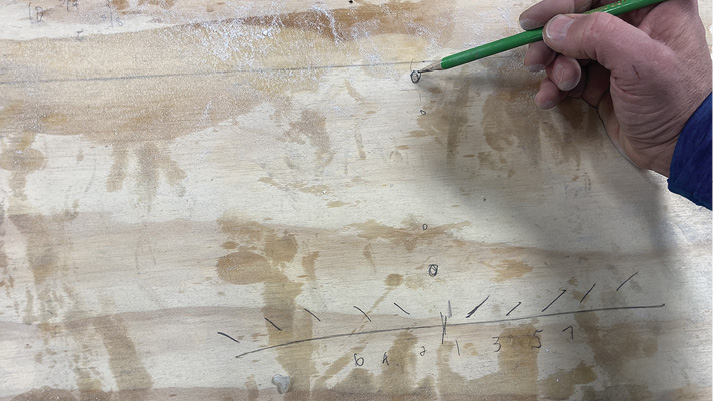
We wear ski racing helmets. That’s really important on these boats because you’re laying down on your back and you have to keep your head up.
The first race of a regatta is a random draw. The odd numbers go this way and the even numbers go that way. Depending on your draw, half the boats line up going off on port, half the boats line up going off on starboard. Somebody will stand and drop the flag and then you run off the line pushing your boat. Once you’ve run as fast as you can, or the boat goes faster than you can run, you jump in!
[Daniel is scribbling furiously] Then these boats all go off, then they tack, then they converge right here on this top mark so you’ll have boats coming in at 60, 70 mph and now the tacks are straight at each other. The closing speeds are very, very fast. They put something in called a darling mark which is about 100 yards above the outer mark and 100 yards below the bottom mark. You get disqualified if you sail between the top mark and the bottom mark and the darling mark. The reason they do that is to prevent port tackers from coming in right on the layline at the top mark, which is very dangerous. This pushes the traffic away from the mark and increases safety. It has the same function as an offset mark.
The rules of sailing are all the same with a couple of exceptions. Boats on the wind (headed into the wind) always have rights over boats off the wind regardless of tack. That’s a huge difference.
[Still scribbling] Let’s say this boat is on port tack going up wind, this boat is on starboard tack going downwind. In soft water this boat would have right of way. In ice sailing it doesn’t matter. Any boat that’s on the wind always has rights over the boat that is off the wind.
After the first race your starting position in the next race is your finishing position in the previous race. So, if I finished sixth in my first race, then that’s where I start in the next race. It always changes.
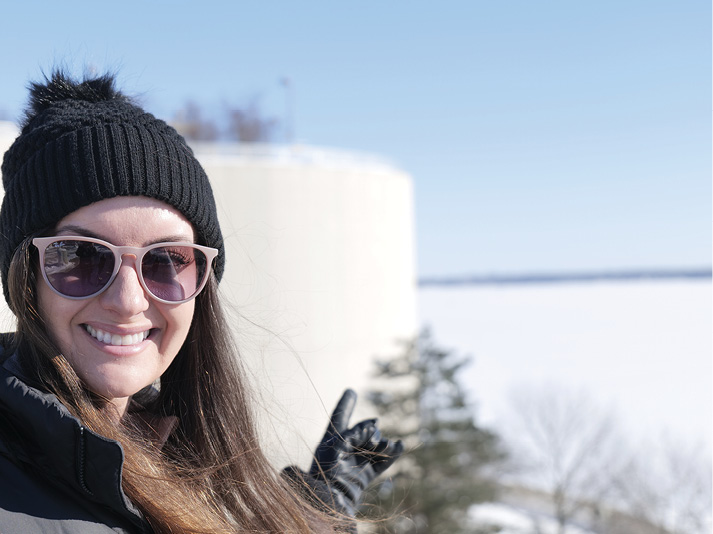
The other difference in ice sailing is this: In soft water sailing, when boats are on the same tack, the leeward boat could force the other boat up. In ice sailing, if the upwind guy needs to go down, so does the leeward boat guy. The reason for that is that if an iceboat gets hit with a puff and starts to hike, you don’t want to turn this way because you could flip over. You want to be able to turn down. So, the leeward boat has to yield in ice sailing.
When you are going 60-70 mph on opposite tacks you’re not yelling “Room!” A few people use rear view mirrors, but that isn’t common. In iceboat racing? It’s really important to know the rules. There are some unwritten rules, too. If boats are converging on each other, they’ll just raise their hand so the other person knows that you see each other. Collisions happen when boats don’t see each other. In sailboats you’re not going that fast and you can holler.
There are some ice yacht clubs. The Four Lakes Ice Yacht Club here in Madison isn’t a brick-and-mortar club. Right now we’re meeting in my office. For regattas we just show up where we’re supposed to show up. And you drag your trailer down the snow ramp. It depends on where the best ice is. Depending on how thick the ice is, we might have a special permit that allows us to drive out on the ice, drop our trailer there, then drive our vehicles out. For the big boats we use wheeled carts to tow them out onto the ice.
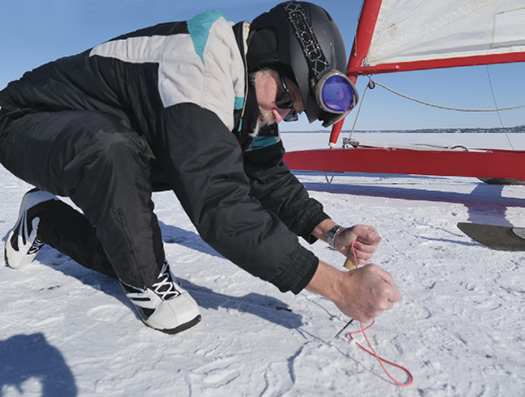
Most iceboaters are soft water sailors, too. Madison is scow country. For iceboating? When there are amazing ice conditions most bosses will let people leave work to sail. But most club racing is on Saturdays and Sundays. If we have good conditions then the racing is called “on” and then all the different classes show up and they race in rotation.
Daniel was just great. He’s incredibly knowledgeable, we learned a lot and I took tons of photos. He followed up with photos via email and I look forward to sending him this column.
Getting Up Close and Personal To A DN
In Jan 2024 I travelled back to Madison again during a particularly cold week. What was I doing there? Well, if you must know, I was responsible for transporting pediatric medical equipment from Waukesha to Madison and back. The roads were black ice and the temperature ranged from negative 10 degrees to no higher than two degrees. Yes, Fahrenheit.
So, there I was, driving around with a colleague in a rented U-Haul cargo van full of tiny little wheelchairs, fishtailing through downtown Madison. U-Haul cargo vans are rear wheel drive, by the way. In 2019 Amy Johanning travelled out from Wisconsin to participate in the Three Bridge Fiasco with me, and she has become a keen aficionada of sailboats. We were sliding from one side of the icy road to the other, when all of a sudden Amy yelled “Look! There’s a sailboat on the lake!” Of course, when I heard that I immediately turned to port and almost sideswiped a cop car. The teeny wheelchairs crashed into each other in the back of the van, but we would not be deterred.
We slid to a stop on an upper parking ramp of the Monona Terrace, which overlooks Lake Monona. Here is a photo of Amy pointing to a speck in the distance: Behold! An iceboat!
We followed the road around the lake all the way to a boat ramp in Olin Park. The ramp had been removed for the winter months, leaving behind a short sled ride from the parking lot to the frozen lake. We were in the Land of Hard Water.
Interview With A DN Sailor In Negative Degree Weather
Changing into shoes with rubber soles, I slid down onto the lake and half ran, half slid over toward a snowman leaning over a sailboat with three skate slides instead of a centerboard. This poor man. Wasn’t it enough that the wind was freezing cold, biting across the icy expanse? Here was a weird woman pestering him.
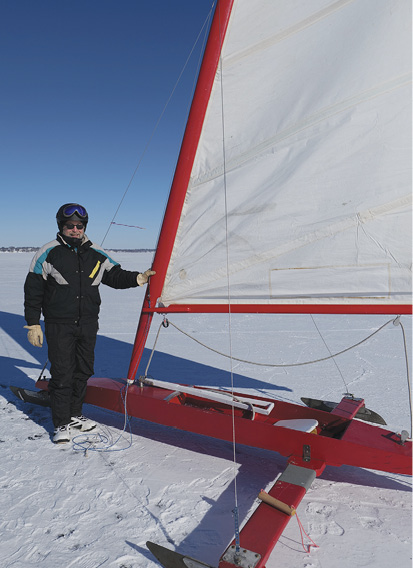
I introduced myself: “Hi! I’m here to write a story about you and your boat for a boating magazine in the San Francisco Bay Area! Whatcha doing? Is it alright if I take your photograph? That’s a beautiful boat you’ve got here. Boy is it cold!”
Carl Houtman looked up. To this day I have no idea what he really looks like behind the helmet, the ski goggles and the scarf, but he did not disappoint. Exhibiting the exquisite manners for which Midwesterners are famous, he nodded. Maybe he smiled. Regardless, he didn’t miss a beat, and here is what he had to say:
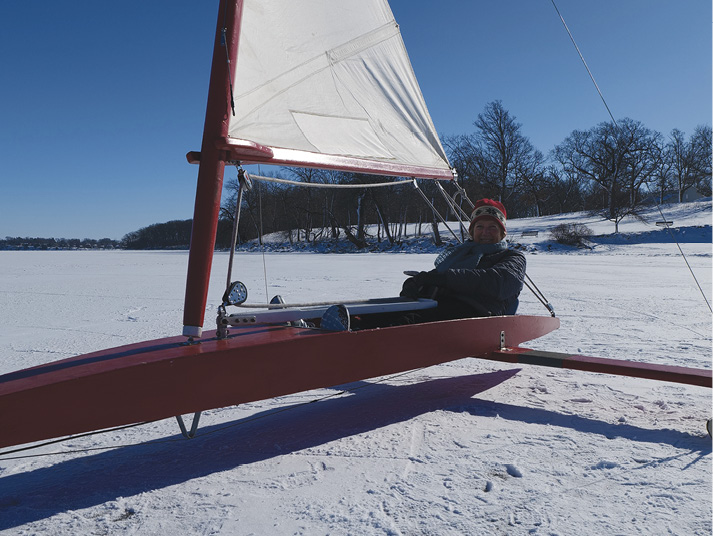
Carl: I don’t know if you know the history of the DN. This boat has a very long tradition here in Madison.
This is a DN, which stands for Detroit News. It is considered a builder plan, probably built in the mid-70s.
He stopped for a moment, shook his head and laughed in that “I’m probably just encouraging this lunatic but maybe if I answer a few questions, she’ll go away” kind of way. I explained that I had learned to sail on the nearby Lake Mendota at the University of Wisconsin’s sailing club. Carl nodded, absorbed this new information and decided to talk with me as a fellow sailor.
C: I was a sailor in my younger days. I was a competitive 470 sailor. What I’m doing right at the moment is I’m actually depowering the boat. Because I found it… pretty windy… We were going fast but I was just on the edge of having too much wind. So I’m raking the mast. We have nice ice today. I’m raking the mast and I’m also going to put a little more play in the stays. The way you set the rake on this particular boat is you set these side stay tensioners at the level that you, well, you kind of are guessing, but somewhere here…
What I’m doing here is raking that mast over so I can do the same tensioning on this side as I did over there. I left five holes over there, I think. Back before climate change started taking over we were in that sweet spot here in Madison. If you go too far north you’re just snowed in. You go too far south and you don’t get enough ice. Historically Madison has enjoyed a very nice sweet spot in terms of the quality of ice and not too cold so that it makes a salad.
[Then Carl asked the magic question]
Do you have any desire to just try it?
My response? “Yes, I’d love to!”
C: Okay. You’re not really dressed for it, but yeah…
J: I’ve been told that every instinct you have as a water sailor is WRONG.
C: That’s not quite right. I would say that, if your instinct is, when you’re getting a little overpowered, if your instinct is to head up? That one’s still accurate. Why don’t I give you these. They are water spikes. I don’t think you’ll need them, but if you break through into the water you can use them to pull yourself out of the water. [Carl demonstrates sticking them into the ice, pulls himself toward them] You would use them like this. To pull yourself out of the ice.
The thing about iceboating is that it’s all about apparent wind. What we do is sail windward leeward courses. As you are rounding the leeward mark sometimes you’ll let out to build power, but you want to get a little more draft. But you’re almost always close hulled.
I told Carl what a sailing friend had told me, which was: “Jackie, in iceboating everything you’ve learned as a sailor can kill you.”
Carl was thoughtful but not very convincing: “Aww… it wouldn’t KILL you kill you. Go ahead and sit in it.”
So I did.
C: I’m gonna tell you a few things: I have the brake on right now. It’s a little spike that’s sitting in the ice right in front of you. See how the front runner has a little bar sticking down? You’re almost straight into the wind right now. Actually let’s do this …”
Carl shifted the boat just slightly and then lifted up the bar on the runner at the front of the boat. I’m sitting in the cockpit and the spike is no longer stopping the boat from moving forward.
The last thing I heard was Carl saying: “This will let you feel it when it’s powered up…”
And then? That boat and I took OFF! As a soft ice sailor, I will tell you this: iceboat sailing offers immediate – and I mean IMMEDIATE forward motion. There is no waiting for the wind to catch your sails and drag the hull through. Now I understand what multihull sailors mean when they say that they’re not “dragging a hull around in the water.” Instead, it was just this: WHOOSH! Sheet in the main and we went really fast. On HARD water. I became acutely conscious that it was not the soft water of the San Francisco Bay below me. Instead, there was really hard, solid ice right there next to me, not down below on the other side of the generous gunwale of my own boat. Then, when I turned into the wind? There was no continued forward movement like with a sailboat. We just stopped right away, I had to get out, shove the boat forward and sheet in again. Then we went WHOOSH! We went really fast again!
Since I didn’t have local knowledge about the parameters of the lake and whether the ice was thick all over… I returned the boat to Carl rather sooner than I would have preferred. Plus, there was that whole inadequately prepared with clothing issue. I was wearing long underwear, a wool sweater and a down jacket, but really? It wasn’t good enough. It was also so cold that I was afraid my camera lens might crack. That would have been bad. So, I returned Carl’s boat, thanked him profusely and ran up the snow bank to my rented U-Haul. I cranked up that heat and shivered for ten minutes. But I’ve gotta tell you: Iceboating? It’s a RUSH.
2024 Three Bridge Fiasco
This year my friend Kees flew in again from Mississippi to race in the Three Bridge Fiasco with me. Since Dura Mater still doesn’t have an engine, we got a tow to the start from Bob Johnston. As soon as the wind came up, he cut us loose and sailed away in his 38-foot Alerion S/V Surprise! looking free as a bird as she skimmed the city front.
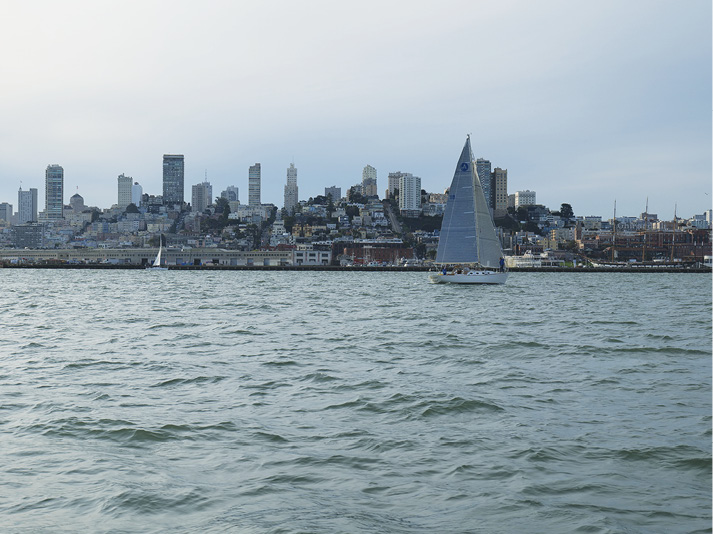
Kees and I rounded two of the marks, Blackaller and then Red Rock, after which we raised our spinnaker. It is always a lovely sight to watch all the other boats raise their spinnakers under the Richmond/San Rafael Bridge and head for the central bay.
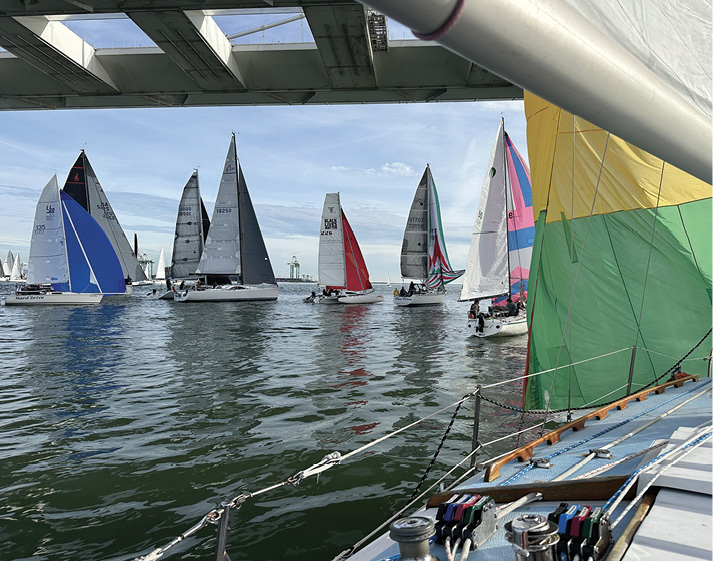
It was a beautiful day on the water that Saturday, and here are the results of the race: https://www.jibeset.net/show.php?RR=JACKYT005347597&DOC=r101&TYP=html
A whole crowd of boats got stuck in the sailboat’s version of a parking lot when the ebb and flood currents met under the Bay Bridge. Here is a photograph taken by Jan Hirsch S/V Sweet Pea, east of Treasure Island.
Kees was at the tiller as we headed for Treasure Island from Red Rock. As we approached the entrance to Potrero Reach I reminded him that we had no engine and asked if he would prefer to quit the race and head for the Richmond Yacht Club bar instead. Kees responded by turning sharply to port, which caused the spinnaker to wrap itself around the forestay. Ah yes. The Fiasco: There is always something to write home about.
A Loss To The Bay Area
In late 2023 the Bay Area and the community of San Rafael lost one of their beloved own. Anthony Alexander Cavallo, fondly known as “Butch,” who peacefully departed on November 27, 2023, in San Rafael, California, at the age of 80. Born in New York, Butch made San Rafael his home since 1981. Renowned as the owner of Hi-Tide Boat Sales and Service, he was a skilled master mechanic specializing in Mercury Marine engines.
Beyond his gruff exterior, Butch harbored a tender heart, displaying a soft spot for kittens and roses. He grew roses on property and took great joy sending flowers to friends. When his two adored cats had their last liter, Butch was found tearing up when giving away the last kitten. Ever ready to assist those in need, Butch undertook the responsibility of warmly welcoming and aiding his neighbors, Helmut and Lisa, as they established Helmut’s Marine Service across from his own business. Following his demanding days at Hi-Tide, Butch would venture across the street after hours, dedicating his time to help them arrange their parts shelves and tackling any other projects that required an additional pair of hands.
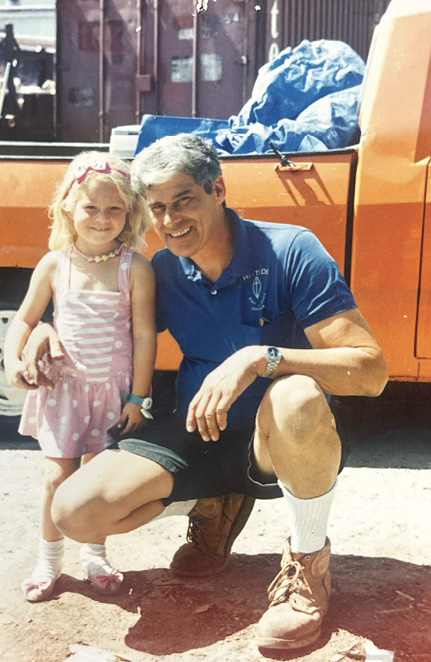
Each year, Butch marked the holiday season with a festive gathering for friends and patrons. These joyous celebrations featured live music, homemade eggplant parmigiana, and abundant servings of cioppino – a testament to his love for those he cherished. His passion for fishing on the bay and managing Hi-Tide Marine underscored that his work was not merely a career but a true calling.
Butch was preceded in death by his mother, Dorothy Cavallo, in 2000, and his father, Vito Cavallo, in 2001. He is survived by his brother Vincent Cavallo, sister Marie Russo, and her life partner Heloise “Petey” Millner. Affectionately known as “Uncle Butch,” he leaves behind devoted nieces and nephews – Anthony Russo, Michael Russo, Lynette, Michael Jr., and Alexa Russo.
Survived by close colleague Caroline Crawford and friends Kirk Hylan, Kelly Peckham, Tim, Lenore Arnoux, and his beloved cat, Gizmo, Butch’s impact will be enduring. In accordance with his wishes, a private celebration of Anthony’s life will be held in the future, commemorating the man who touched so many hearts with his kindness and generosity.
Hurrica Restaurant
In early February I was invited to visit the new restaurant at the Westpoint Marina, named after Mark Sanders’ classic wooden yacht S/V Hurrica. If you’ve ever watched the Master Mariners Regatta on the bay, you’ve seen Hurrica, and most likely she’s been winning the race. Down in Redwood City she is front and center, tied up at the long guest dock just outside the newly built club at Westpoint. The club has been in temporary quarters upstairs in the harbormaster’s building for years but has recently moved into the upstairs of this drop dead beautiful new building. Upstairs is the yacht club, downstairs is the restaurant, Hurrica.
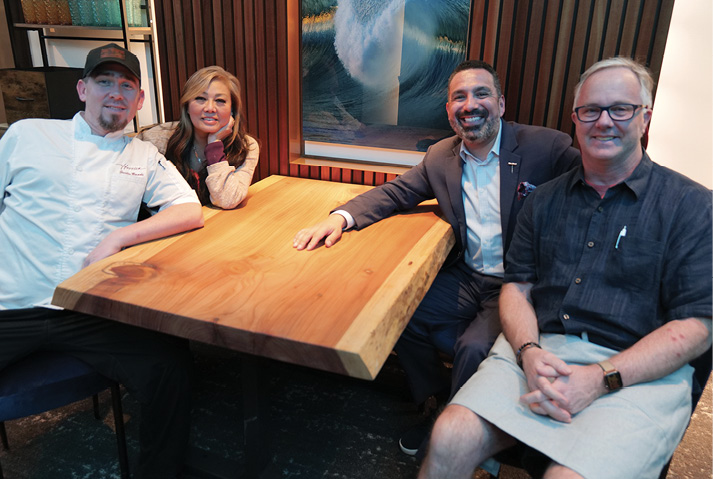
It’s quite a stunning place and I highly recommend a visit. Especially remarkable is the floor to ceiling fish tank full of hundreds of baby octopi. Yes, hundreds. They are mesmerizing.
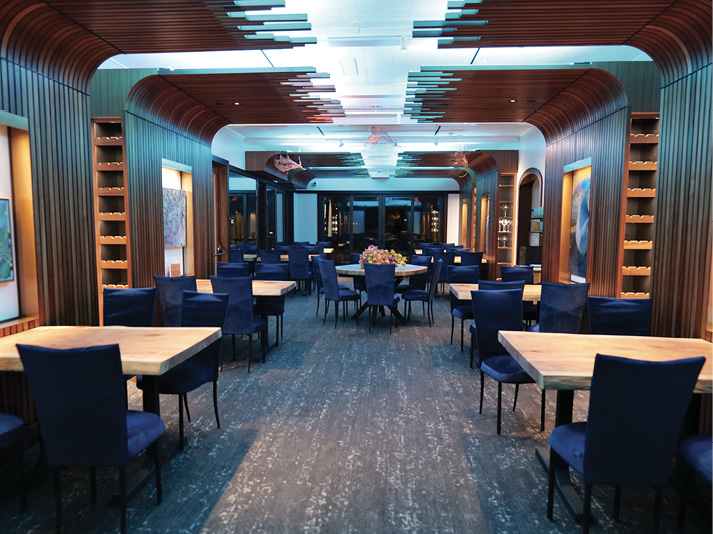
I was introduced to the two partner/owners, MeeSun Boice and Parke Ulrich, and to Erick Cadena, General Manager/partner and Chef/Partner, Justin Baade. MeeSun and Parke are also partners in other local restaurants, the Mersee on Treasure Island, the Epic and Waterbar restaurants, both on the Embarcadero in the City.
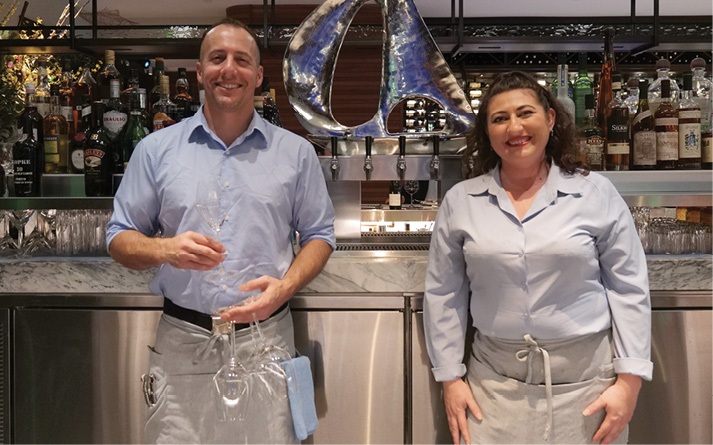
MeeSun told me that she was particularly proud of the fact that she paid back the investors in Mersee within four years.
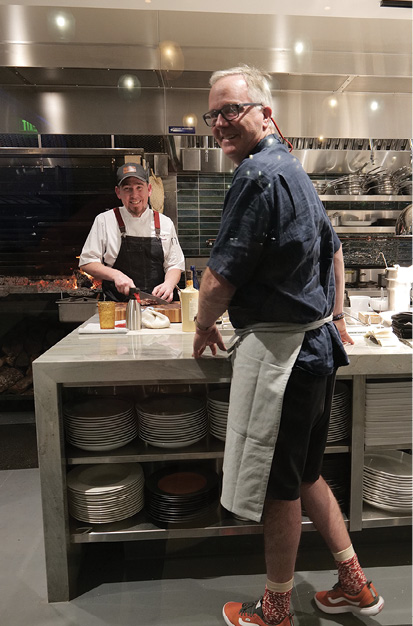
During these recent times when restaurants are closing everywhere, staying in business is no small feat, let alone paying off investors. I know it. You know it. If we expect restaurants to be there when we want to go out to eat somewhere special? Then we need to support them while they’re still in business. This is a particularly beautiful restaurant. Maybe go eat there while you’re at this year’s boat show.
This year the Pacific Sail and Power Boat Show will be at Westpoint Harbor on May 16-19. Maybe call now for your lunch or dinner reservation.
Until next month, thank you for reading. Let me know at jackie@yachtsmanmagazine.com if you have anything you would like to share. Enjoy your time on the water and let’s all be careful out there.



